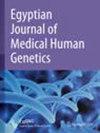他汀类药物使用者的基因多态性及其他归因因素与血脂状况之间的关系:一项横断面回顾性研究
IF 1.2
Q4 GENETICS & HEREDITY
引用次数: 0
摘要
众所周知,他汀类药物具有改善血脂状况的功效。他汀类药物的疗效因人而异,并可受遗传多态性等患者因素的影响。本研究采用横断面回顾性设计,评估了选定的单核苷酸多态性(SNPs)和其他患者特异性临床变量对他汀类药物相关的马来西亚人亚群血脂变化的影响。在他汀类药物治疗前(基线)和治疗后(两个范围的治疗持续时间,即≤6个月和7-12个月),评估了低强度和中等强度他汀类药物剂量(10-40毫克/天,至少6周)(不考虑他汀类药物的类型)对先前确定的与他汀类药物疗效和血脂谱变化有临床关系的基因的SNPs的影响。从患者静脉血(3 mL)中提取 DNA,采用 PCR-RFLP 方法进行 SNP 基因分型。利用显性遗传模型,研究了六个相关基因(ABCG2、ABCC2、APOE、APOA5、GATM 和 COQ2)中所选 SNP 与患者血脂谱之间的关联。研究共纳入了 229 名接受过他汀类药物治疗的患者。患者平均年龄为(53 ± 7.16)岁,大部分为女性(53.3%)、马来人(96.1%),服用阿托伐他汀和辛伐他汀(90.4%)。所调查的六个基因中的七个 SNPs 基因分型与他汀类药物治疗前后不同的血脂状况有关。基线时,ABCG2 rs2231142(P = 0.035)和APOA5 rs662799(P = 0.007)变体的HDL-c水平较高,而ABCC2 rs717620变体的TC(P = 0.040)和LDL-c水平(P = 0.022)较高。他汀类药物治疗后,ABCC2 rs717620(降低 TG,P = 0.009)和 APOA5 rs662799(提高 HDL,P = 0.031;降低 TG,P = 0.037)与血脂状况的改善有关,这种关联与携带 SNP 小等位基因的男性密切相关。在他汀类药物治疗期间,所研究的 SNPs 均与他汀类药物相关的降低 LDL-c 的显著效果无关。为了更好地了解他汀类药物治疗期间血脂状况的个体间异质性,在使用他汀类药物前后考虑患者的遗传学和性别会有所帮助。本文章由计算机程序翻译,如有差异,请以英文原文为准。
Association between genetic polymorphisms and other attributing factors with lipid profiles among statin users: a cross-sectional retrospective study
Statins are well known for their efficacy to improve lipid profiles. Their efficacy varies between individuals and can be modified by patient factors such as genetic polymorphisms. This study used a cross-sectional retrospective design to assess the effect of selected single nucleotide polymorphisms (SNPs) and other patient-specific clinical variables on statin-related lipid profile changes in a subgroup of Malaysians. The impact of low and moderate intensity of statin doses (10–40 mg/day for at least six weeks), regardless of statin types, was assessed between SNPs of previously identified genes with clinical relation to statin efficacy and lipid profile changes before (baseline) and after statin treatment; two ranges of treatment durations, i.e. ≤ 6 months and 7–12 months. DNA was extracted from patient's venous blood (3 mL), and SNP genotyping was performed using PCR–RFLP method. Using a dominant genetic model, the association between selected SNPs from six genes of interest (ABCG2, ABCC2, APOE, APOA5, GATM and COQ2) and the patients' lipid profiles was investigated. A total of 229 statin-treated patients were included. The mean age of the patients was 53 ± 7.16 years, and they were mostly females (53.3%), Malay (96.1%), and were taking atorvastatin and simvastatin (90.4%). Seven SNPs genotyped from six genes investigated were related to different lipid profile before and after statin treatment. At baseline, ABCG2 rs2231142 (P = 0.035) and APOA5 rs662799 (P = 0.007) variants had higher HDL-c levels, while ABCC2 rs717620 variants had higher TC (P = 0.040) and LDL-c levels (P = 0.022). Following statin treatment, ABCC2 rs717620 (lower TG, P = 0.009) and APOA5 rs662799 (higher HDL, P = 0.031; lower TG, P = 0.037) were associated with improved lipid profiles, with the association being substantially related to males carrying minor alleles of the SNPs. None of the investigated SNPs were related to significant statin-related LDL-c lowering effects during statin therapy. To better understand inter-individual heterogeneity in lipid profiles during statin therapy, it would be helpful to take patient genetics and gender into consideration before and after administering statins.
求助全文
通过发布文献求助,成功后即可免费获取论文全文。
去求助
来源期刊

Egyptian Journal of Medical Human Genetics
Medicine-Genetics (clinical)
CiteScore
2.20
自引率
7.70%
发文量
150
审稿时长
18 weeks
 求助内容:
求助内容: 应助结果提醒方式:
应助结果提醒方式:


